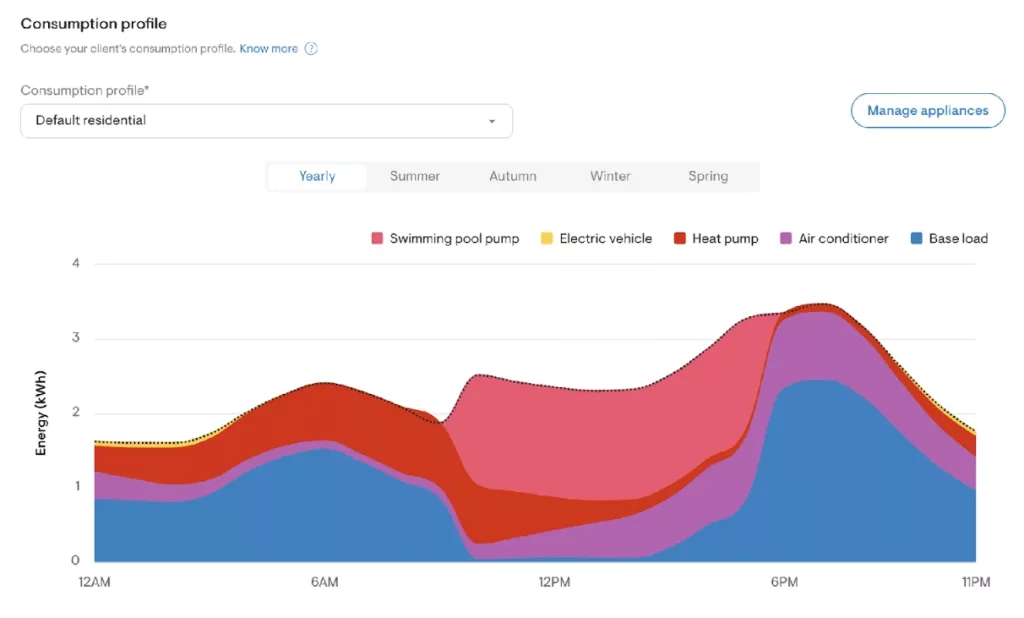Modern challenges require modern tools. The success of a solar system installation is rooted in understanding the customer’s energy needs to provide accurate sizing and a tailor-fit solar solution. This article, designed for solar installers, dives into the details of calculating the customer energy requirements for solar system sizing and introduces the powerful capabilities of the Solargraf platform.
Defining Customer Goals – Consumption vs. Bill Offset
The first step to tailoring a solution requires a clear understanding of customer objectives. Considering the customer’s budget and available roof space will determine the ideal balance between the two approaches:
- Consumption Offset: Targeted at minimizing grid energy consumption, it informs the percentage of solar production compared to the consumption. For back-fed sources like solar, the National Electric Code (NEC) allows the sum of the main breaker and the solar back-fed breaker to be up to 120% of the panel’s busbar rating. It accounts for the idea that the main breaker and the solar source are unlikely to deliver their total current simultaneously. Most utilities also limit system size to offset 150% of the energy used in kWh (kilowatt-hours) over the past 12 months.
- Bill Offset: Focused on maximizing cost savings, this method is ideal for systems when the utilities have tiered pricing or time-of-use rate schedules. It is because, with a battery system, bill offset optimizes for maximum self-consumption during peak tariffs to provide the best value. However, a bill offset can rarely be 100% because most utilities will still charge a minimum fee to connect to their grid.
Understanding Energy Needs – Entering Project Consumption
Once the goal is defined, the subsequent step involves understanding customer energy requirements through either of the four approaches on Solargraf:
- Uploading Green Button DataGreen Button is a standardized format for consumers to download and analyse their energy data to make informed choices about their energy usage. With a simple and secure process, customers can securely download or share their energy usage data in an industry-standard format with registered third parties. Uploading customers’ Green Button Data on Solargraf is the most accurate way to understand their energy requirements.
- Direct Consumption InputSolargraf allows installers to input customer consumption directly by entering an annual/average (across 12 months) consumption number, month-wise consumption number, or consumption for a custom duration. The more granular the consumption entered, the more accurate the modeling. The entered consumption is then extrapolated across 15-minute intervals for a year to model energy needs.

- Decoding the Electricity BillCustomer electricity bills can be used by the installer to understand the energy requirements by converting them to energy usage using tariff details and selected consumption profiles. Solargraf lets installers input electricity costs as an annual average, by the month, or for a custom duration. The more granular the duration, the more accurate the modeling.
- Estimation based on property sizeProperty size-based estimations are employed when usage or bills are unavailable. Although the least accurate method, it serves as a baseline by entering the property size to estimate energy usage per square foot.
Selecting a Consumption Profile
It is important that the customer’s consumption profile reflect usage patterns, including seasonal/hourly variations that can significantly impact the modeling, mainly when the tariff includes a time-of-use rate structure. Solargraf offers pre-defined profiles based on typical household usage patterns, including options for creating custom profiles. Installers must account for any future high-energy appliances before designing the system. Solargraf supports electric vehicles (EVs), pool pumps, heat pumps, and air conditioners with pre-defined consumption profiles for each.

Designing the System – Solar Panel Selection and Sizing
Entering customer energy requirements, optimal solar panels, and storage selection ensure project efficacy. Installers must:
- Consider solar panel dimensions, efficiency, and local sun exposure.
- Account for potential challenges such as shading, ambient temperature variances, losses, and installation angles.
- Leverage storage solutions to maximize efficiency.
- Compute the required system size using the goals defined in the previous step.
Solargraf’s platform automates much of this, offering efficiency and precision.
The Solargraf Advantage
Solargraf stands out as an indispensable asset for solar installers. The platform provides flexibility in defining customer energy requirements and usage patterns, facilitating accurate modeling. With a wide range of pre-defined settings, Solargraf saves time and reduces the chances of human error. Additionally, it offers up-to-date tariff information, aiding installers in making the best choices for their customers.

By designing proposals with Solargraf and considering vital factors like customer energy goals and local irradiance factors, installers can deliver high-performing, cost-effective systems, ultimately enhancing customer satisfaction.
There has never been a better time to try Solargraf. Schedule a demo today.


 United States
United States Germany/Austria
Germany/Austria Brazil
Brazil Netherlands
Netherlands